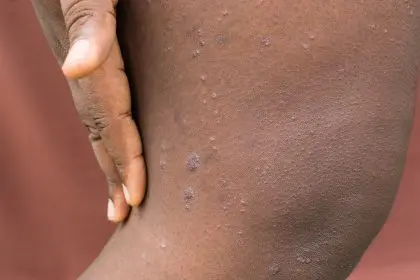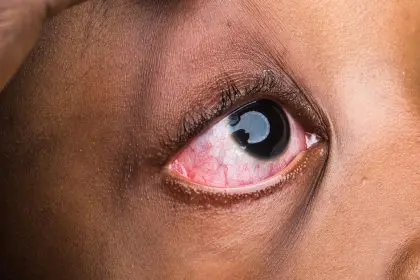When it comes to skin health, understanding conditions that specifically affect darker skin tones can make all the difference in proper treatment and prevention. From delayed cancer diagnoses to visible pigmentation changes, individuals with melanin-rich skin face unique challenges that require specialized attention.
The truth about dark skin and health
Skin problems don’t just affect physical health—they can deeply impact self-confidence and emotional wellbeing, especially when visible on the face or exposed areas. Many people don’t realize that similar-looking rashes may require entirely different treatments depending on skin tone. And contrary to popular belief, excessive cleansing often worsens skin conditions by damaging the skin’s natural protective barrier.
Darker skin has unique properties that affect how conditions present and respond to treatment. Understanding these differences is crucial for proper care.
Here are five important skin conditions that people with darker skin tones should monitor:
1. Skin cancer requires vigilance despite lower risk
While skin cancer occurs less frequently in people with dark skin (accounting for only about 2% of all cancers in Black individuals), it’s often diagnosed at later stages, resulting in worse outcomes. This delayed detection happens because both patients and doctors may not recognize early warning signs in darker skin.
People with melanin-rich skin should examine their skin monthly, paying special attention to palms, soles, fingernails, and toenails. Watch for changing moles or unusual spots, especially under nails or between toes. Apply broad-spectrum sunscreen daily, particularly to exposed areas, and visit a dermatologist yearly for professional skin checks. Seek medical attention immediately for any suspicious changes.
The myth that melanin-rich skin doesn’t need sun protection can be dangerous, UV damage affects all skin types, just in different ways.
2. Eczema appears differently on darker skin
Eczema (dermatitis) creates itchy, inflamed skin patches that can appear ashy or grayish on darker skin rather than the reddish appearance seen on lighter skin tones. This difference sometimes leads to misdiagnosis or delayed treatment.
This common condition often begins in childhood but can develop at any age. It frequently affects urban residents exposed to environmental pollutants and creates tiny cracks in the skin that increase infection risk. Eczema may worsen with certain fabrics, soaps, or environmental factors and can lead to post-inflammatory hyperpigmentation after healing.
Treatment typically involves moisturizing regularly, identifying and avoiding triggers, and using prescription topical medications when necessary. Some research suggests probiotics may help prevent flare-ups by strengthening the immune system.
3. Adult acne can lead to lasting pigment changes
Many adults with dark skin experience acne well beyond their teenage years. This frustrating condition often appears during hormonal shifts like pregnancy, menopause, or stress periods. Without proper treatment, acne can leave lasting dark spots (hyperpigmentation) that take months or years to fade.
Contributing factors include hormonal fluctuations affecting oil production, diet choices (particularly high-glycemic foods and dairy products), and certain medications or cosmetics that clog pores. Stress can trigger inflammatory responses, and hair products containing oils that contact facial skin may also worsen acne.
Effective management includes gentle cleansing without over-scrubbing, non-comedogenic moisturizers, and targeted treatments containing ingredients like salicylic acid or retinoids. Keeping a food diary can help identify dietary triggers that worsen breakouts.
4. Vitiligo creates striking contrast in darker skin
Vitiligo causes the immune system to attack melanin-producing cells, creating patches of completely depigmented skin. While this autoimmune condition affects all skin types equally, the contrast between normal and affected skin appears most dramatic on darker skin tones.
Key facts about vitiligo: it’s not contagious or life-threatening, but can significantly impact quality of life. Patches may appear symmetrically on both sides of the body, and treatment focuses on stopping progression and repigmenting skin. Sun protection prevents burning of affected areas lacking melanin protection. Vitiligo patients often need vitamin D supplementation since they must limit sun exposure.
Treatment options include topical corticosteroids, calcineurin inhibitors, phototherapy, and in some cases, surgical approaches. Advances in immunomodulating therapies offer new hope for managing this challenging condition.
5. Psoriasis often goes unrecognized in darker skin
Psoriasis accelerates skin cell turnover, creating thick, scaly patches that may appear darker or more violaceous (purplish) on melanin-rich skin rather than the bright red seen on lighter skin tones. This difference in appearance often leads to misdiagnosis or underdiagnosis in darker-skinned individuals.
This chronic condition can appear anywhere but commonly affects elbows, knees, scalp, and lower back. It may trigger or worsen with stress, infections, or injuries to the skin and increases risk for other health problems including arthritis and cardiovascular disease. Psoriasis tends to run in families, suggesting a genetic component, and requires ongoing management rather than one-time treatment.
Comprehensive care typically involves topical treatments, light therapy, oral medications, or biologics depending on severity. Lifestyle modifications like stress reduction, smoking cessation, and limited alcohol consumption help minimize flare-ups.
Taking control of your skin health
As our largest organ and first line of defense, skin deserves careful attention. For people with darker skin tones, early recognition and treatment of skin conditions prevents the lasting pigmentation changes that can occur after inflammation heals.
The good news? Effective treatments exist for all these conditions. Working with a dermatologist familiar with diverse skin types ensures you receive appropriate care tailored to your specific needs. With proper knowledge and proactive management, you can maintain your skin’s natural beauty and health for years to come.
















